
The persistence of the canard that India was once a rich country is understandable. A quick glance at the simple graph illustrates very clearly why it is easy to conclude that India was rich.
This piece has loads of graphics — more than any other piece I ever wrote. No arguments here, just a lot of data-based graphics.
Here’s the TL;DR version: India is not rich today, and really never was rich in the past. In fact, all countries were poor until about a thousand years ago. India had a large share of the world GDP because India’s population was a large share of the world population. India was not rich. It was merely big. Just like it is today: big and poor. Like China used to be just a few decades ago.
National income accounts are a modern invention. Therefore historical estimates are understandably rough, although painstakingly arrived at by scholars such as Angus Maddison who have spent decades researching these specialized matters. But they can be relied upon to be suggestive of what the past was like. The errors in the estimates do not alter the arguments that rely on those estimates.
Big Guys on the Block
As is readily apparent, in the year 1CE, India and China accounted for over half of the world GDP, with India alone over 25 percent of the world GDP. Therefore, the argument goes, India used to be rich.
Not that I was there to witness India’s richness in the past, but from all data available now I conclude that India was not rich. It was not exceptionally poor either but it was certainly not rich.
How can that be when India alone accounted for around a quarter of the world GDP as late as 1700CE as the image above shows? The answer is simple: India had a large share of the world population and that explains why its share of the world GDP was large (relative to what it is today.)
In other words, India wasn’t rich. India was just big and quite poor. Much like today.
The World Changes
We may be forgiven for thinking of the world in static terms. Very little appears to change in the short attention span — a few years at most — we have regarding large variables such as the wealth and populations of nations. It seems to us that what we see today was pretty much what it was must have been like in the past. But that’s seriously mistaken. The world changed dramatically over the centuries in the past.
The world used to be dirt poor. It used to be poorer than the poorest parts of the world today. Things have changed though. Now some parts of the world are so rich that the poorest of their residents are richer than the richest rulers of the past centuries. That’s another amazing story that is not sufficiently appreciated. That story suggests that sometime in the future, the poorest of the future will be richer than the richest of the present. (That’s another post.)
Anyway things have changed. World population and wealth has steadily increased, and the distribution of both have changed over time.
World Population
Consider world population. As of Aug 2016, there were 7.4 billion people on earth. That’s a truckload of people. But it wasn’t always like that. At some point in the past, there were fewer humans on earth than the number of people airborne in commercial jetliners at any instant of time today.
Assume 500 planes up in the air at any moment and assume 100 passengers per plane. That’s 50,000 people not on terra firma. Sometime between 20kya and 40kya (thousand years ago), the human population fell to around 2,000 persons. The human species went through a population bottleneck. That’s not uncontroversial but it’s out there.
In any event, here are some population data of interest. From the US Census Bureau, Historical Estimates of World Population page:
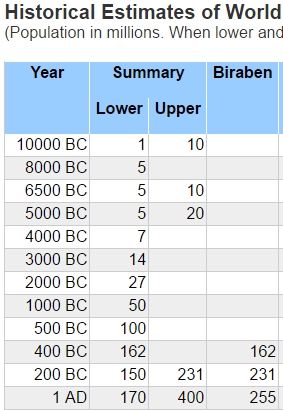
Around 12,000 years ago, there were between 1 million and 10 million humans. Around 3,000 years ago, there were 50 million people. About 2,000 years ago, that figure went up to between 170 million and 400 million.
Think about it. The annual rate of population growth must have been tiny. (Too lazy to do the actual computation right now.)
Here’s how the population increased. The first billion was reached around 1804, the second 123 years later in 1927, the third merely 33 years later in 1960. Subsequent billions were added just in 14, 13 and 12 years apart. In 1999, world population was 6 billion, and in 2011, 7 billion. Now, as noted earlier, the population is around 7.4 billion.
India is the second most populous country now but will over take China in a few year.
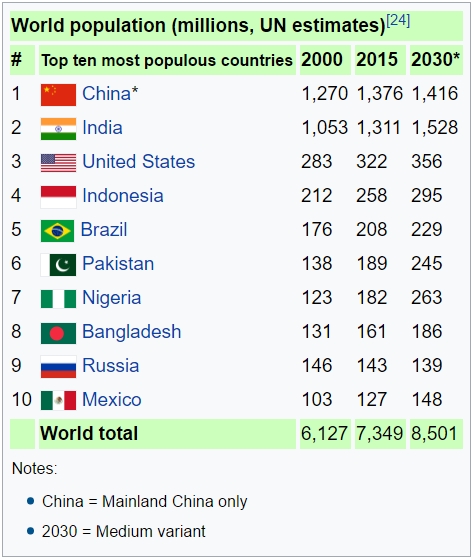
The consequences of billions of people are staggering. Some extremely bad and some amazingly good. But that’s a topic for another day.
It is interesting to note that the distribution of population is extremely uneven. In the following figure, around 5 percent of the world population lives in the red area, and another 5 percent lives in the blue area.
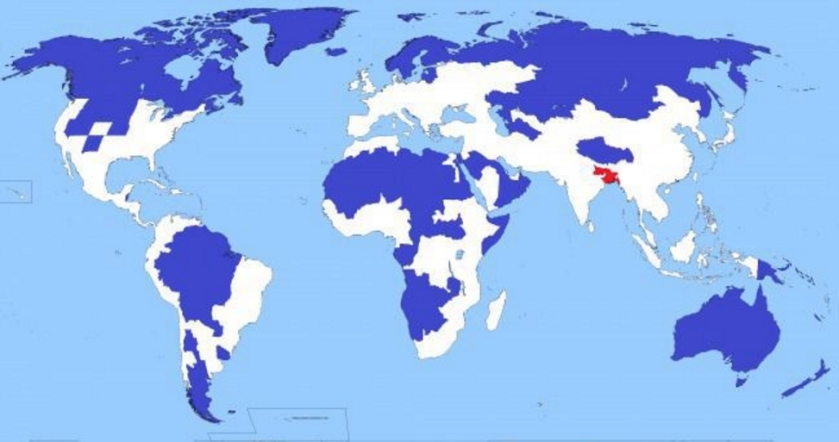
China and India — and parts of Western Europe — have been around for a while. The new kid on the block is the United States. It was tiny when it was first colonized by Europeans. Around the time of its independence in 1776, the population was less than four million. Today both the geographical size and population are much bigger compared to when it began. And it has become immensely wealthy too.
The World’s Income
Wealth is hard to estimate. So let’s talk income. Here are some graphics showing the change in world GDP over time. [Source.] As you scroll down, you will note a distinct patter: the yellow bar at the top representing India’s share of the world GDP mostly shrink throughout history.
Here’s a summary of the shifting fortunes of those nations in one plot:
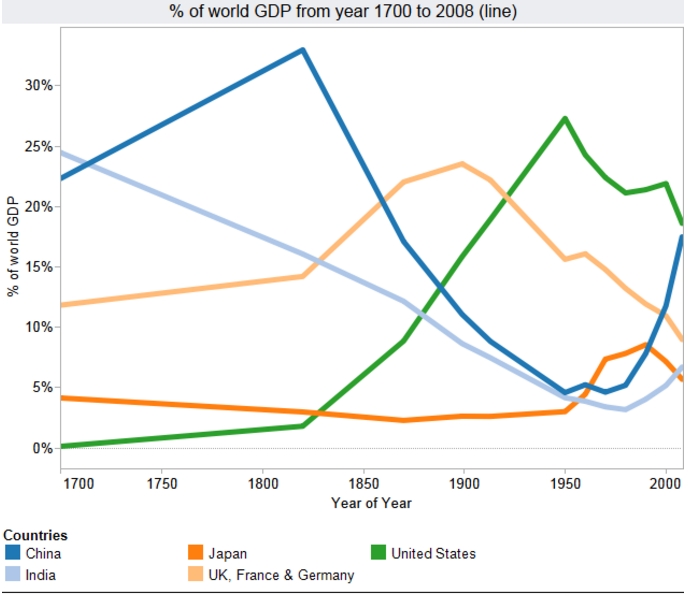
The United States went from zero to around a quarter of the world’s GDP in less than 200 years. That’s amazing. How did it manage that? Short answer: it adopted a set of rules that allow people to create wealth. What set of rules: individual freedom, free markets and private property rights. Read the US Constitution for the specifics.
Per Capita GDP
Clearly India’s economy has been steadily losing ground for many centuries. In per capita terms, the story is even more disturbing. See this:

When the East India Company started in 1600, Britain’s per capital GDP was around $1000 and India’s around $550. When India was effectively taken over by the East India Company in 1757, India’s GDP had not changed but Britain’s GDP per capita had gone to around $2000.
It appears from the table above that India’s GDP per capita barely moved from 1500 to 1950. The GDP per capita went from $550 to $619 in 450 years.
China Leaves India in the Dust
Note also, China was always ahead of India in per capita GDP terms except for the first half of the 20th century CE. Socialism accounts for that but the moment China turned even a little bit towards free markets, it took off like a rocket (which, if you know your history, is a Chinese invention.) In 1950, China’s per cap GDP was $180 below India’s — a good 30 percent below India. In 1998, China’s GDP per cap was $1400 more than India’s — around 80 percent higher than India.
India’s socialist policies have doomed it to be an also ran in the race for economic development. (May Gandhi, the Congress party, Nehru & his spawn rot in hell.)
India appears to be the amazing shrinking economy. India has been shrinking not in absolute terms but relative to the rest of the world, and especially so relative to China. China’s rise does not bother me but India’s decline does. The sad thing is that Indians are not really aware of that, and consequently they have little reason to worry or change their leadership so that India can catch up with the rest of the developed world.
NOTES:
Much of the data comes from Angus Maddison’s work. The World Economy: A Millennial Perspective by Angus Maddison Copyright 2001 OECD. Table on pg 90. Many of the images are from Infogr.am which are based on data derived from The Maddison Project.
The per capita GDP figure is from working paper #4 of The Maddison Project.
{This is part of a work in progress called “The Wealth of Nations.”}









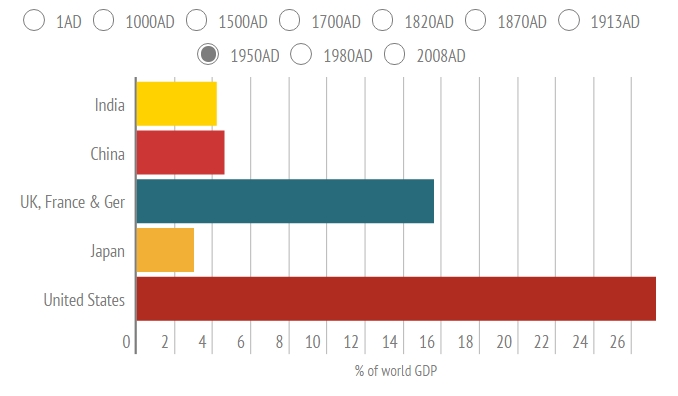
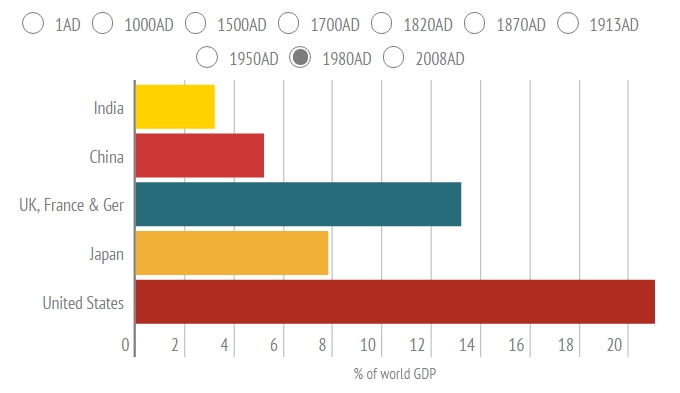
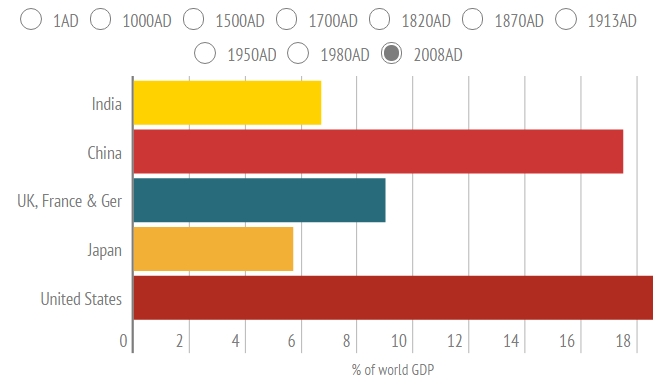
good explanation with data ,Atanu, it should be thrown in the faces of those people that say ‘ india was golden chidiya’ and britisher’s robbed india.
LikeLike
But India is growing at 7%-8%. Dont you think that within a few decades india will catchup with the rest of the world.
My question to you is that why do you think nehru didnt invest in educating india being SOCIALIST.
LikeLike
Certainly India will catch up at the rate at which it is growing — provided of course that the rest of the world stops dead on its tracks or even better if it starts shrinking. But I would not place my bets on those things happening.
Nehru did not invest in education because he was too poorly educated to realize the value of education. He thought that all that was needed for a country to prosper was for someone privileged like him to occupy the “commanding heights of the economy” and dictate to the uneducated, unwashed masses.
LikeLike
“Short answer: it adopted a set of rules that allow people to create wealth. What set of rules: individual freedom, free markets and private property rights. Read the US Constitution for the specifics.”
You make this very simple. Like people just have to pick up a copy of john locke and ayn rand that they are convinced that govt should be bounded by constitution that, tht free markets are good and that rich people are not the enemey but actually the driving force of our world.
But I think the truth is more towards one old post of yours where you say “freedom is an acquired taste” and indians definitely have not. Now we must dig up the reasons for this.
And this might not rub you well but I think the hindu religion plays a part here. And the “hindu rate of growth” was probably apt and still is. For this too I found quotes on this blog itself:
“Gautier should have continued with the Will Durant quote: The Hindus had allowed their strength to be wasted in internal division and war; they had adopted religions like Buddhism and Jainism, which unnerved them for the tasks of life”
“Weakened by division, it succumbed to invaders; impoverished by invaders, it lost all power of resistance, and took refuge in supernatural consolations; it argued that both mastery and slavery were superficial delusions, and concluded that freedom of the body or the nation was hardly worth defending in so brief a life.”
I think the underlying point(which is not being discussed is)hinduism ended up attacking is—masculinity.
Every civilization rose only to the levels of power and glory as it’s men could take it to. In india men were bound by dogmas of various forms of servitude. This is something i like to call “automatic respect”, the idea that one’s elders in the house are by default always right and should be obeyed no matter what.
This is still strongly embedded in men’s minds even now. And this automatic respect inside the family has now just grown and is being projected to the authority like teachers, yogis, priests, the govt. Simply put no one in authority should be questioned and debated on principles of reason and logic but just followed.
Is it any wonder that even today indian men are so notoriously famous for being mama’s boys. And the stereotype no doubt fits. Even today the most western minded indian men will cow to their families on choices like marriage—it’s almost funny in a sense. They simply have no backbone.
And when you live life this just respecting elders and authority by default it becomes a habit. And with a habit like this why would anyone pick up a book? Or even read? This should explain the reason that india is not a country of books at all. The stats will show you that most people simply do not read. Even the highly educated rich read nothing in this nation, they have no curiosity whatsoever because everything has been taken care of by the habit of just obeying, agreeing and following. So there goes any hope of self education on the mertis of liberty etc.
Compare this to the american “pursuit of happiness”. Their culture is one where teenages leave the parental house by 17 and “acquire the taste of freedom’’.
I think in the end it’s the individual psychologies of people which will explain economic policies of a nation a lot better than the idea that those policies were just imposed by a nehru or a benjamin franklin.
LikeLike
Hallo almostaristotle! (Love the name :)) anyway couldn’t agree with you more that its mass psychology which is to blame for india’s ills rather than just that little cunning elite pulling all the strings in lutyens’ delhi. But re buddhism – if it unnerves men for the tasks of life how does one explain japan, south korea, china’s success? I’m not asking you to be irritating but because i’d seriously like to know. This argument of emasculation by buddhism was advanced in a conversation to me by someone else too but i didn’t get a chance to ask him re buddhist countries prosperity. And for that matter, jainism has had quite an influence on gujarat but that’s one of india’s best performing states (disclosure: i’m a jain though in name only). Hope this reaches you. Anyway, very glad to know that atleast a few on the economic right believe the malaise is wider than just the Establishment. Bbye!
LikeLike
“Here’s the TL;DR version: India is not rich today, and really never was rich in the past. In fact, all countries were poor until about a thousand years ago”
The definition of rich and poor you’re using is bull†**! The old India population was way lower, currency wasn’t globally dependent, natural resources weren’t all govt controlled. INDIA was richer in that time.
It’s ECONOMY no matter what moaning and bitching you do about “teh poor ppl” was growing at a healthy rate and would have evetually benefited those very poor people.
Key word “GROWTH” without economic growth ANY Country is doomed.. so let’s see:-
#1 Brits came and gave us a NEGATIVE economic growth for over a century!
#2 Nehru stagnated the economy
#3 After liberisization our economy has finally seen a positive growth… Since like over a goddamn century!
So no! India was RICH and would have been richer if India’s first PM wasn’t goat raping Nehru.
LikeLike
Gurumurthy tweeted this today:
LikeLike
ECO,
Thanks for the link to Gurumurthy’s tweet. One of these days, yes, one of these days I will have to take the time to write a detailed post on Shri Gurumurthy.
LikeLike